Spirit Airlines Bundle
How Does Spirit Airlines Fly High in a Competitive Market?
Spirit Airlines, the pioneer of the 'Bare Fare' model, has revolutionized air travel by offering ultra-low-cost flights. From its humble beginnings as a charter tour operator, Spirit has transformed into a major player, challenging traditional airlines and captivating budget-conscious travelers. This article dives into the core of Spirit's success: its innovative sales and marketing strategies.
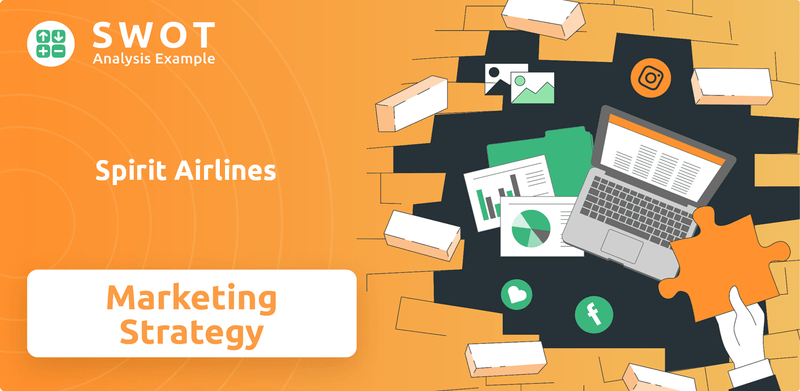
Understanding the Spirit Airlines SWOT Analysis is crucial to grasping how this airline leverages its strengths and mitigates weaknesses in its sales and marketing efforts. Its success as an ultra-low-cost carrier hinges on a carefully crafted sales strategy and a marketing approach that consistently attracts its target audience. We'll explore the intricacies of its business model, examining how Spirit Airlines generates revenue and maintains its competitive edge through strategic pricing, targeted advertising, and effective customer acquisition strategies within the dynamic airline industry.
How Does Spirit Airlines Reach Its Customers?
The sales strategy of Spirit Airlines centers on a direct-to-consumer model, primarily utilizing its official website, Spirit.com. This approach enables the airline to directly manage bookings, sell ancillary services, and handle customer interactions. This strategy minimizes reliance on third-party distributors, supporting the ultra-low-cost carrier (ULCC) business model.
A key component of Spirit's sales and marketing strategy is its mobile app, which offers a convenient booking experience and flight management features. The airline also operates call centers for customer service and bookings, catering to customers who prefer direct assistance. This multi-channel approach supports customer acquisition strategy and enhances the overall customer experience.
The evolution of Spirit's sales channels reflects a shift towards digital platforms, aligning with industry trends and consumer preferences. The company invests in enhancing its website and mobile app to streamline bookings and promote ancillary services, a significant revenue driver. This focus on direct digital sales helps maintain a low-cost structure. For example, in 2023, the airline's digital channels likely accounted for a substantial portion of bookings and ancillary revenue, although specific figures are proprietary.
Spirit.com is the cornerstone of sales, handling bookings and ancillary services. This e-commerce platform enables direct customer interaction. It minimizes costs associated with third-party distribution.
The mobile app offers a convenient booking experience and flight management. It aligns with the increasing trend of digital adoption. This enhances customer acquisition and engagement.
Call centers provide direct assistance for bookings and customer service. They cater to customers who prefer personalized support. This channel complements digital platforms.
The emphasis on digital channels supports the ultra-low-cost structure. It reduces distribution costs and enhances revenue generation. This strategy is crucial for maintaining profitability.
Spirit Airlines' sales strategy focuses on direct-to-consumer channels, primarily its website and mobile app, to maintain its ultra-low-cost structure. This approach allows the airline to control the customer experience and reduce distribution costs, which is a crucial element of its business model. The airline also utilizes call centers to support customers who need direct assistance, ensuring a comprehensive approach to sales and customer service.
- Direct Website Sales: Spirit.com is the primary channel for bookings and ancillary service sales.
- Mobile App: The app provides a convenient booking experience and flight management features.
- Call Centers: These offer direct customer service and booking assistance.
- Digital Focus: This strategy supports the ultra-low-cost model by reducing distribution costs. For detailed information on the airline's target audience, consider reading about the Target Market of Spirit Airlines.
Spirit Airlines SWOT Analysis
- Complete SWOT Breakdown
- Fully Customizable
- Editable in Excel & Word
- Professional Formatting
- Investor-Ready Format
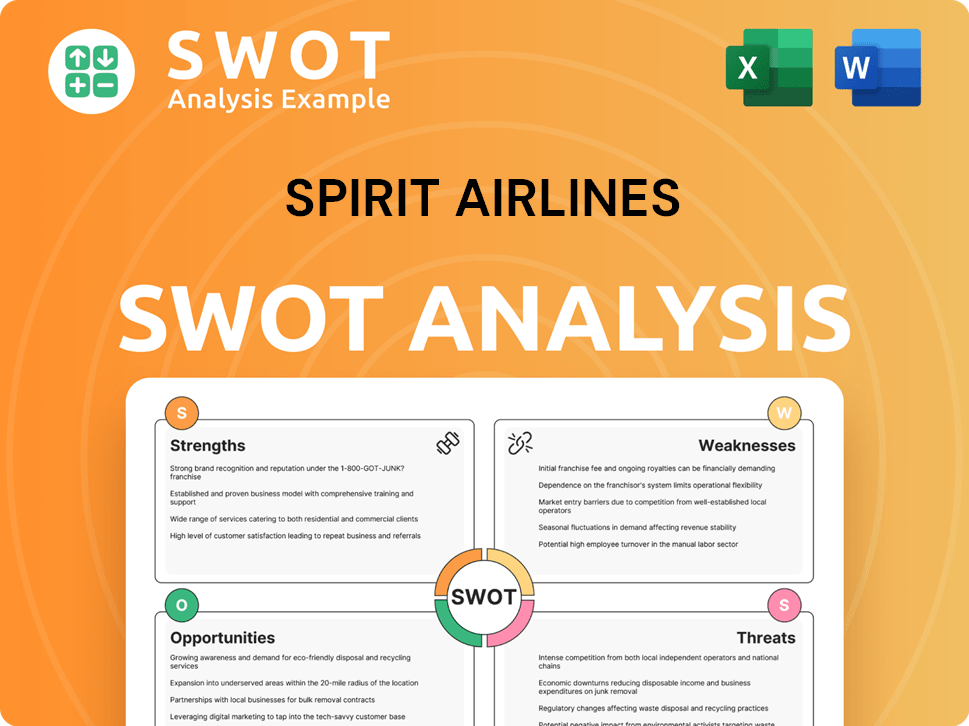
What Marketing Tactics Does Spirit Airlines Use?
The marketing tactics of Spirit Airlines are primarily geared toward promoting its ultra-low fares and driving direct bookings. This strategy heavily relies on digital marketing, with a significant emphasis on paid advertising across various online platforms. The airline's approach is data-driven, aiming to segment its customer base and personalize offers to attract budget-conscious travelers.
Digital marketing forms the core of the Spirit Airlines sales strategy, utilizing paid advertising on search engines and social media to target potential customers actively seeking affordable flights. Email marketing is also a key component, used for promotional campaigns and fare alerts, as well as direct communication with members of its loyalty program. While less prominent than digital efforts, content marketing through its blog offers travel tips and destination guides.
Spirit Airlines’ marketing mix has evolved with a clear focus on digital efficiency and direct response, aligning with its ultra-low-cost carrier (ULCC) model. The airline's marketing is heavily integrated with its 'unbundled' product, consistently emphasizing the low base fare as the primary draw and then clearly presenting the options for additional services. This approach is crucial for its customer acquisition strategy and overall revenue generation.
Paid advertising on search engines and social media platforms is a cornerstone of Spirit Airlines' marketing efforts. This targets budget-conscious travelers actively seeking affordable flights. The focus is on driving direct bookings through these channels.
Email marketing plays a crucial role in promoting special offers and fare alerts. It also facilitates direct communication with members of the Free Spirit loyalty program. This helps in customer retention.
Content marketing is implemented through its blog, offering travel tips and destination guides. This helps in subtly promoting its routes. This approach supports the overall brand positioning.
Spirit Airlines leverages social media platforms for direct engagement and rapid responses. This includes disseminating deals and addressing public inquiries. This approach enhances customer service.
Data-driven marketing is used to segment the customer base and personalize offers. This often highlights specific low fares for popular routes. This approach improves targeting effectiveness.
Traditional media, such as TV or radio advertisements, is used selectively during peak travel seasons. This supports major promotional pushes. This approach is less frequent than digital efforts.
Spirit Airlines' marketing strategy is designed to attract budget-conscious travelers and increase direct bookings. The airline's approach emphasizes digital efficiency and direct response, which is crucial for its ultra-low-cost carrier model. This strategy is supported by data-driven analytics.
- Digital Focus: The primary focus is on digital channels for advertising and customer engagement.
- Cost-Effectiveness: Marketing efforts are designed to be cost-effective, aligning with the ULCC business model.
- Direct Bookings: The strategy aims to drive direct bookings through the airline's website and app.
- Data Analytics: Analytics tools are used to optimize advertising spend and target efforts.
- Unbundled Product: Marketing highlights the low base fare and clearly presents options for additional services.
The effectiveness of Spirit Airlines' sales and marketing strategy is evident in its ability to maintain a strong presence in the competitive airline market. For example, in 2024, the airline reported a load factor (percentage of seats filled by paying passengers) of approximately 81.8%, indicating efficient utilization of its capacity. This efficiency is a direct result of its targeted marketing efforts and revenue management strategies. The Brief History of Spirit Airlines provides additional context on the company's evolution and its strategic approach to the market.
Spirit Airlines PESTLE Analysis
- Covers All 6 PESTLE Categories
- No Research Needed – Save Hours of Work
- Built by Experts, Trusted by Consultants
- Instant Download, Ready to Use
- 100% Editable, Fully Customizable
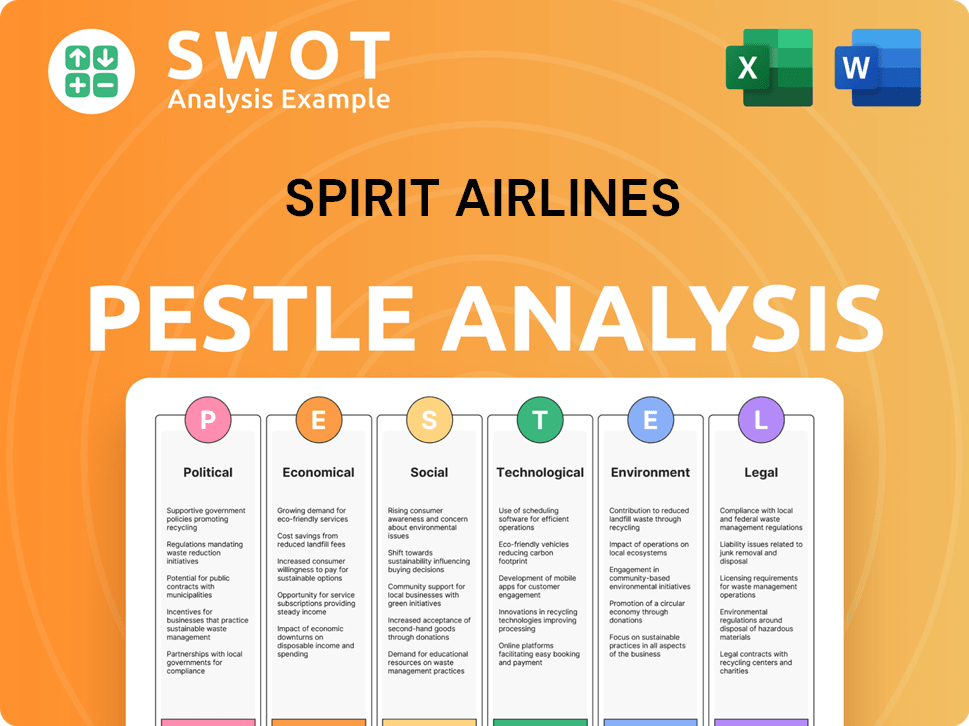
How Is Spirit Airlines Positioned in the Market?
The brand positioning of Spirit Airlines centers on being the leading ultra-low-cost carrier (ULCC). This strategy is built around the 'Bare Fare' concept, which allows customers to pay only for the services they choose. This approach is a core element of their identity, designed to attract budget-conscious travelers.
Spirit's visual identity, highlighted by its distinctive yellow aircraft, is immediately recognizable. The airline's marketing and customer interactions use a direct, value-focused tone, sometimes with a touch of playfulness. This reinforces its no-frills, affordable travel ethos.
The customer experience is designed around affordability and efficiency, not luxury. Spirit offers a transparent pricing model with a very low base fare, with extras like baggage and seat selection available à la carte. This strategy appeals to travelers who prioritize cost savings.
Spirit Airlines' core strategy focuses on providing low base fares, appealing to budget-conscious travelers. This approach allows customers to pay only for the services they need, like baggage or seat selection. This is a key element in their Growth Strategy of Spirit Airlines.
The airline uses a transparent pricing model where the base fare is kept exceptionally low. Additional services are offered at extra cost, giving customers control over their spending. This strategy is fundamental to its sales and marketing efforts.
The distinctive yellow aircraft and branding are designed for high visibility. This bold approach helps in instant recognition and reinforces the brand's identity in a competitive market. It is a key part of their airline marketing strategy.
The customer experience prioritizes affordability and efficiency. This means focusing on getting passengers to their destination at a low cost. This approach is a key component of their sales tactics effectiveness.
Spirit Airlines' brand positioning is a critical element of its business model, influencing its sales and marketing strategy. The airline's focus on the ultra-low-cost carrier (ULCC) model shapes its approach to customer acquisition and revenue generation.
- Bare Fare Philosophy: This is the core of the brand, offering low base fares and charging extra for add-ons.
- Target Audience: Primarily budget-conscious travelers who value cost savings over amenities.
- Marketing Tone: Direct, value-focused, and sometimes playful to reinforce the no-frills ethos.
- Pricing Strategy: Transparent pricing with a low base fare, allowing customers to customize their experience.
- Customer Service Perception: While facing challenges, the focus remains on the value proposition.
Spirit Airlines Business Model Canvas
- Complete 9-Block Business Model Canvas
- Effortlessly Communicate Your Business Strategy
- Investor-Ready BMC Format
- 100% Editable and Customizable
- Clear and Structured Layout
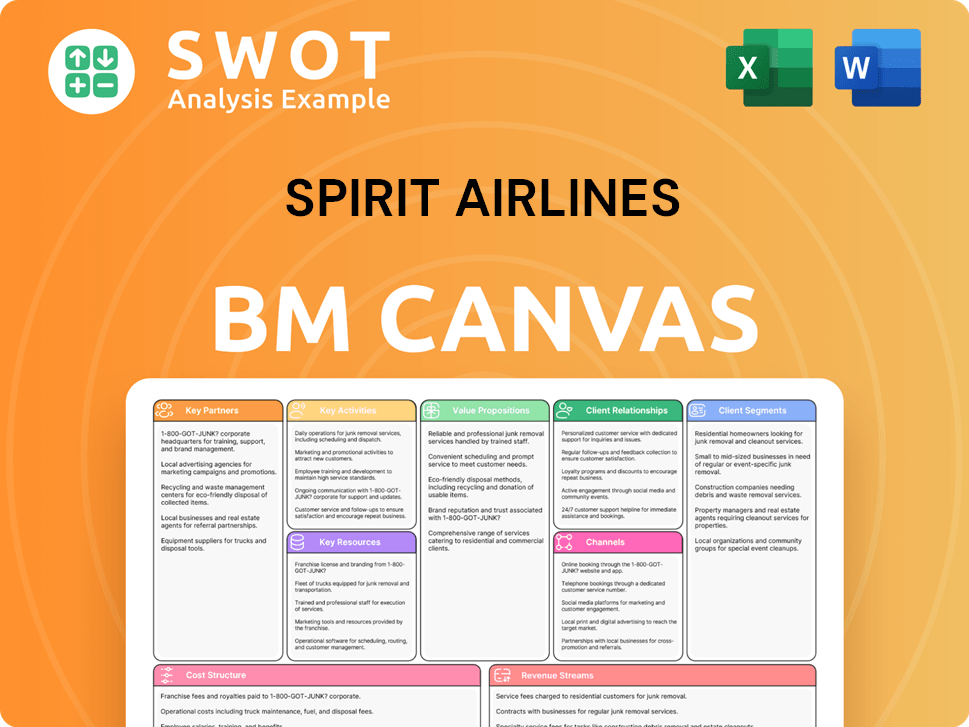
What Are Spirit Airlines’s Most Notable Campaigns?
The Growth Strategy of Spirit Airlines heavily relies on its sales and marketing strategy, primarily focused on driving direct bookings through ultra-low fares. Spirit Airlines' marketing strategy involves a mix of direct-response campaigns, emphasizing low prices and expanding routes. These campaigns are crucial for filling flights, a key element of their business model as an ultra-low-cost carrier.
Spirit Airlines' sales strategy is designed to maximize revenue by offering a 'Bare Fare' and charging extra for services. This approach is communicated through its marketing campaigns, which are distributed via digital channels. The core of Spirit Airlines' marketing strategy is to highlight the value of its unbundled fares and drive immediate bookings through urgency and special offers.
The effectiveness of the Spirit Airlines sales strategy is measured by direct sales lift, website traffic, and engagement rates on digital platforms. The marketing campaigns are closely tied to the airline's operational strategy of expanding its fleet and adding new destinations. This focused approach is central to the company's customer acquisition strategy.
Spirit Airlines leverages digital channels, including email marketing, paid search, and social media, to promote its sales and marketing campaigns. This digital marketing strategy allows for targeted advertising and immediate booking capabilities.
The core of Spirit's marketing centers on the 'Bare Fare' concept, emphasizing the base price and the potential for significant savings. This is designed to attract budget travelers and drive immediate bookings.
Spirit Airlines frequently runs promotional campaigns tied to seasonal travel deals, new route launches, and limited-time fare sales. These offers create urgency and encourage immediate bookings.
The success of Spirit's marketing campaigns is evaluated through direct sales lift, website traffic, and engagement rates. This data-driven approach allows for continuous refinement of sales tactics.
The primary objective of Spirit's marketing campaigns is to drive immediate bookings. This is achieved by highlighting the 'Bare Fare' concept and the potential for significant savings. The focus is on converting website visitors into paying customers.
Spirit Airlines heavily invests in digital advertising, including paid search and social media promotions. This allows for targeted reach and cost-effective customer acquisition. Digital channels are crucial for their marketing strategy.
Email marketing to Free Spirit loyalty members is a key component of Spirit's sales and marketing strategy. This allows for personalized promotions and targeted offers to repeat customers. Loyalty programs drive customer retention.
Word-of-mouth and earned media coverage contribute to Spirit's brand visibility. The unique business model often generates media attention, boosting brand recognition among budget travelers.
Crisis management for Spirit involves direct communication and reiteration of its value proposition. This is particularly important in response to public discussions about fees or operational challenges. Transparency is key.
Spirit's revenue management strategies are crucial for maximizing profitability. This includes dynamic pricing and ancillary revenue generation. The goal is to optimize revenue per available seat mile (RASM).
In 2024, Spirit Airlines reported a load factor (percentage of seats filled) of approximately 80%, indicating strong demand. The airline's revenue per available seat mile (RASM) is a critical metric, with fluctuations depending on fuel prices and market conditions. Customer acquisition costs are carefully managed through targeted digital campaigns.
- Load Factor: Approximately 80% in 2024.
- Digital Ad Spend: Optimized for maximum ROI.
- Revenue per Available Seat Mile (RASM): Monitored closely.
- Customer Acquisition Cost: Managed through targeted digital campaigns.
Spirit Airlines Porter's Five Forces Analysis
- Covers All 5 Competitive Forces in Detail
- Structured for Consultants, Students, and Founders
- 100% Editable in Microsoft Word & Excel
- Instant Digital Download – Use Immediately
- Compatible with Mac & PC – Fully Unlocked
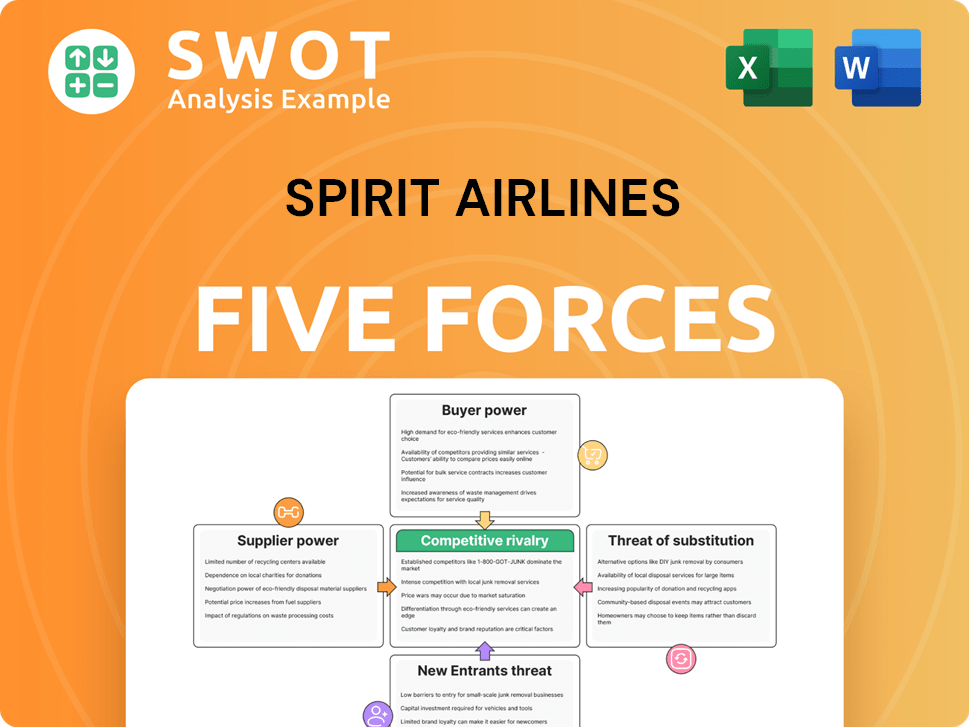
Related Blogs
- What are Mission Vision & Core Values of Spirit Airlines Company?
- What is Competitive Landscape of Spirit Airlines Company?
- What is Growth Strategy and Future Prospects of Spirit Airlines Company?
- How Does Spirit Airlines Company Work?
- What is Brief History of Spirit Airlines Company?
- Who Owns Spirit Airlines Company?
- What is Customer Demographics and Target Market of Spirit Airlines Company?
Disclaimer
All information, articles, and product details provided on this website are for general informational and educational purposes only. We do not claim any ownership over, nor do we intend to infringe upon, any trademarks, copyrights, logos, brand names, or other intellectual property mentioned or depicted on this site. Such intellectual property remains the property of its respective owners, and any references here are made solely for identification or informational purposes, without implying any affiliation, endorsement, or partnership.
We make no representations or warranties, express or implied, regarding the accuracy, completeness, or suitability of any content or products presented. Nothing on this website should be construed as legal, tax, investment, financial, medical, or other professional advice. In addition, no part of this site—including articles or product references—constitutes a solicitation, recommendation, endorsement, advertisement, or offer to buy or sell any securities, franchises, or other financial instruments, particularly in jurisdictions where such activity would be unlawful.
All content is of a general nature and may not address the specific circumstances of any individual or entity. It is not a substitute for professional advice or services. Any actions you take based on the information provided here are strictly at your own risk. You accept full responsibility for any decisions or outcomes arising from your use of this website and agree to release us from any liability in connection with your use of, or reliance upon, the content or products found herein.